Are you looking to transform your fitness journey without expensive gym equipment? A calisthenics workout plan might be precisely what you need. Using just your bodyweight, calisthenics offers an accessible, practical approach to building strength, endurance, and mobility that has stood the test of time.
Many people mistakenly believe calisthenics is only for gymnasts or advanced athletes performing impressive feats on bars and rings. The truth? Calisthenics is for everyone, regardless of your current fitness level. This comprehensive guide will walk you through everything you need to know to start your calisthenics journey and progress from beginner to advanced.
Table of Contents
The Calisthenics Fundamentals
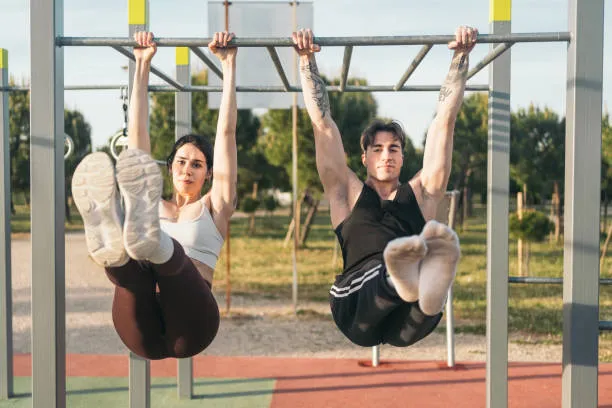
Bodyweight Mastery: Basic Exercises
The foundation of any effective calisthenics workout plan rests on mastering these fundamental movements:
Squats
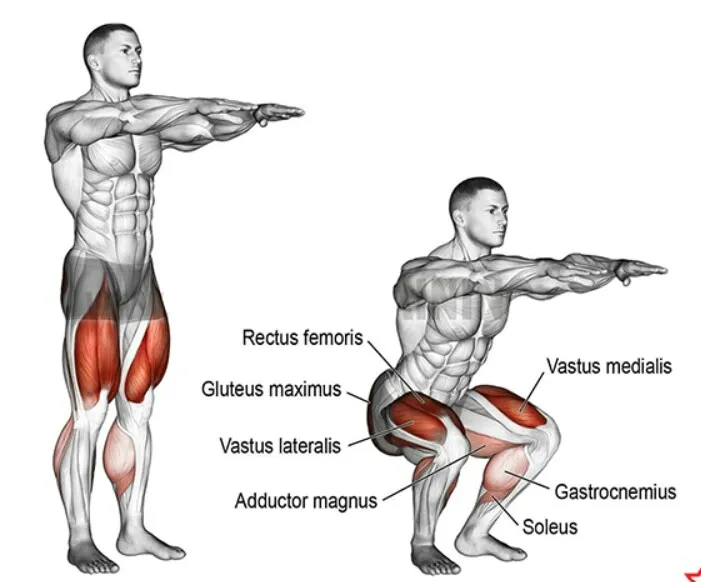
The humble squat builds lower body strength, mobility, and functional movement patterns.
- Form tip: Keep your weight in your heels, chest up, and knees tracking over toes.
- Progression: Bodyweight squat → Jump squat → Pistol squat
Push-ups
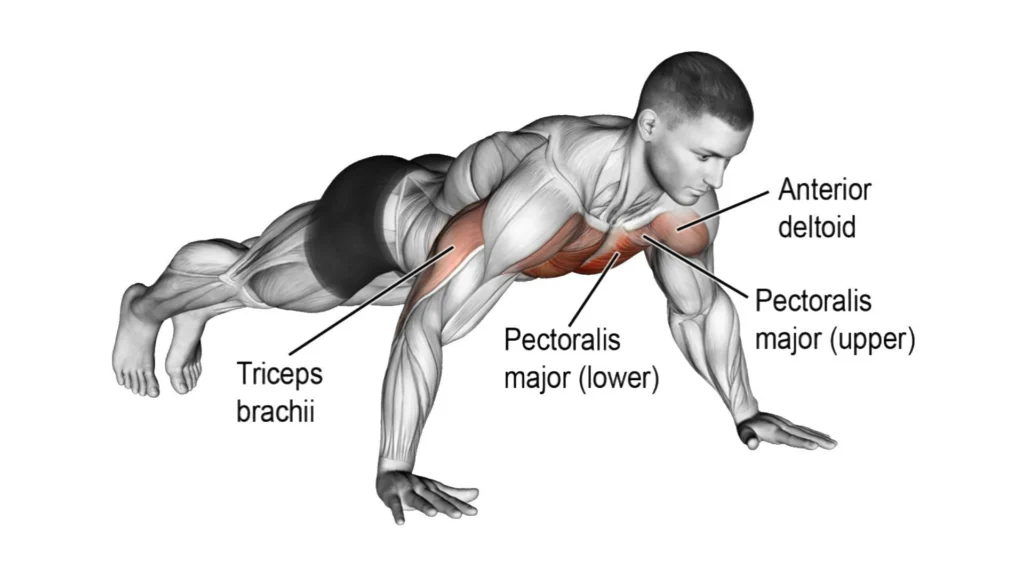
The ultimate upper body builder that targets chest, shoulders, triceps, and core.
- Form tip: Maintain a straight line from head to heels, elbows at a 45° angle.
- Progression: Wall push-ups → Knee push-ups → Standard push-ups → Decline push-ups
Pull-ups
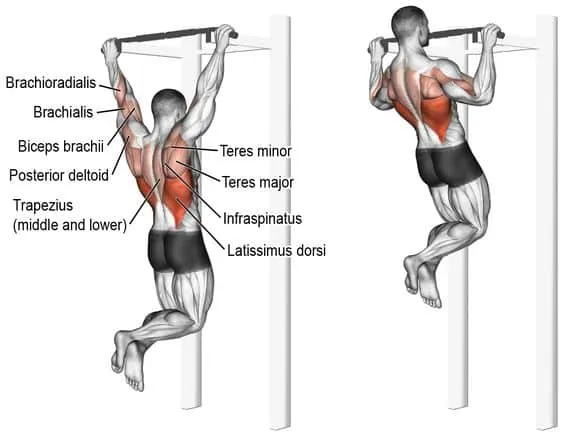
The king of back exercises that builds upper body pulling strength.
- Form tip: Initiate with your back muscles, not arms, and pull your chest to the bar.
- Progression: Negative pull-ups → Band-assisted pull-ups → Full pull-ups
Planks
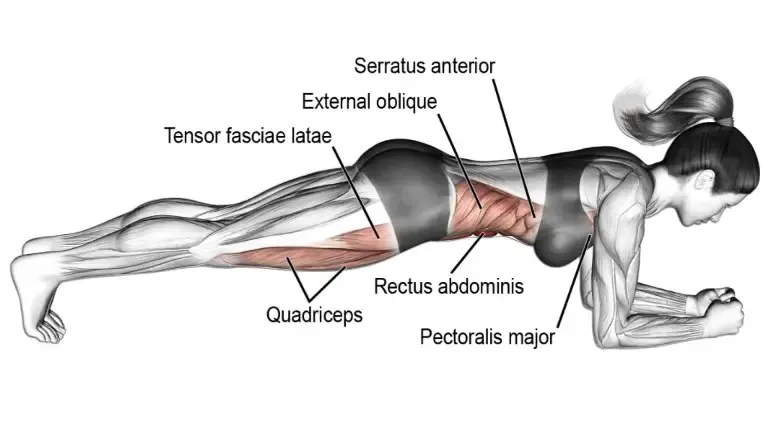
The core stabiliser that improves posture and prevents injury.
- Form tip: Keep your body straight, engage your core, and don’t let your hips sag.
- Progression: Forearm plank → High plank → Side plank
Progression & Regression: Modifying Exercises for Different Levels
One of the most powerful aspects of a calisthenics workout plan is its scalability. Every exercise can be:
- Regressed: Made easier for beginners
- Progressed: Made more challenging as you develop strength
This built-in progression system ensures that you constantly challenge your muscles in new ways—a key principle for continued growth and development.
Form & Technique: Injury Prevention
Proper form isn’t just about efficiency—it’s about safety. According to a 2020 study in the Journal of Strength and Conditioning Research, correct technique during bodyweight exercises reduces injury risk by up to 60%.
Key technique principles to remember:
- Maintain neutral spine positioning
- Control movements through a full range of motion
- Focus on quality over quantity
- Listen to your body’s signals
The Biomechanics of Calisthenics
Research from the American College of Sports Medicine has shown that calisthenic exercises activate multiple muscle groups simultaneously, improving neuromuscular coordination and functional strength. Unlike isolated machine exercises, calisthenics movements mimic natural human movement patterns, making strength gains highly transferable to daily activities and sports.
A 2022 study published in the Journal of Sports Sciences found that regular calisthenics training improved bone density by 3-7% over a 6-month 6 monthsle to traditional weight training but with reduced joint stress.
Beginner Calisthenics Workout Plans
Plan 1: The Foundation Builder
This 4-week plan focuses on mastering the basic movements and building a solid foundation.
Frequency: 3 times per week (Mon/Wed/Fri) Duration: 30-40 minutes
| Exercise | Week 1-2 | Week 3-4 |
| Bodyweight Squats | 3 sets x 12 reps | 3 sets x 15 reps |
| Knee/Wall Push-ups | 3 sets x 8 reps | 3 sets x 12 reps |
| Inverted Rows | 3 sets x 8 reps | 3 sets x 10 reps |
| Plank | 3 sets x 20 seconds | 3 sets x 30 seconds |
| Glute Bridges | 3 sets x 12 reps | 3 sets x 15 reps |
Rest 60-90 seconds between sets, and ensure proper form throughout.
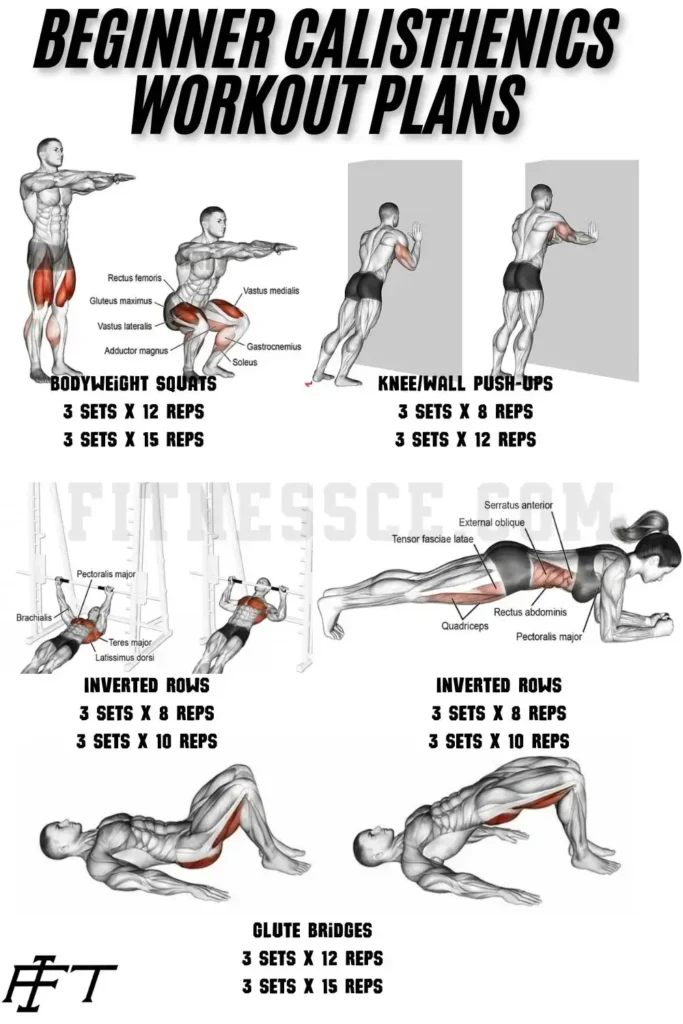
Plan 2: The Bodyweight Bootcamp
Ready for something more intense? This circuit-style calisthenics workout plan will challenge your strength and endurance while maximizing calorie burn.
Frequency: 3 times per week Duration: 25-30 minutes
Complete 3-4 rounds of:
- 45 seconds of Jumping Jacks
- 45 seconds of Push-ups (modify as needed)
- 45 seconds of Air Squats
- 45 seconds of Mountain Climbers
- 45 seconds of Bicycle Crunches
- 15 seconds rest between exercises
- 90 seconds rest between rounds
Beginner Calisthenics Warm-up and Cool Down Routine
Warm-up (5-7 minutes):
- Arm circles: 30 seconds forward, 30 seconds backward
- Hip rotations: 15 each direction
- Leg swings: 15 each leg, forward and sideways
- Shoulder rolls: 30 seconds
- Jumping jacks: 30 seconds
- Bodyweight squats: 10 slow, controlled reps
- High knees: 30 seconds
Cool Down (5-7 minutes):
- Quad stretch: 30 seconds each leg
- Hamstring stretch: 30 seconds each leg
- Child’s pose: 30 seconds
- Chest opener: 30 seconds
- Deep breathing: 1 minute
“The best calisthenics workout plan is the one you’ll stick with. Start where you are, not where you think you should be.” – Al Kavadlo, Calisthenics Expert.
Intermediate Calisthenics Workout PlansYou can progress to these more challenging workouts ass you build strength and confidence with the beginner routines.
Plan 1: The Strength & Muscle Builder
This split routine focuses on building significant muscle mass and strength through progressive calisthenics.
Frequency: 4 days per week Duration: 45-50 minutes
Day 1: Pull Focus
- Pull-up variations: 4 sets x 6-10 reps
- Inverted rows: 3 sets x 12 reps
- Bodyweight bicep curls: 3 sets x 15 reps
- Superman holds: 3 sets x 30 seconds
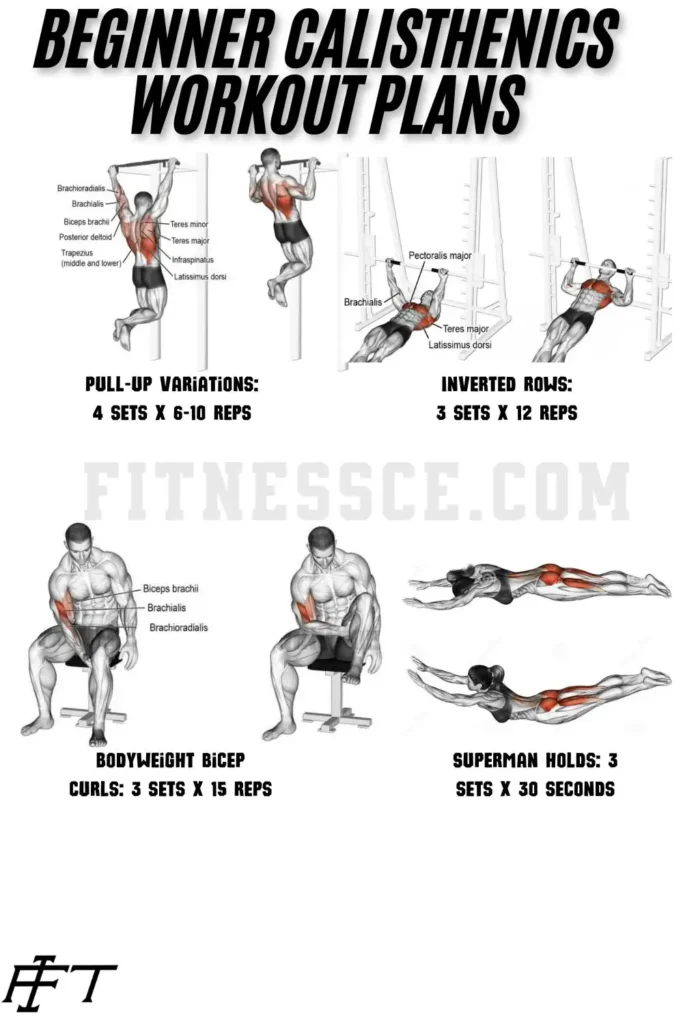
Day 2: Push Focus
- Push-up variations: 4 sets x 10-15 reps
- Pike push-ups: 3 sets x 10 reps
- Dips: 3 sets x 8-12 reps
- Diamond push-ups: 3 sets x 8-12 reps

Day 3: Legs Focus
- Bodyweight squats: 4 sets x 20 reps
- Walking lunges: 3 sets x 12 each leg
- Jump squats: 3 sets x 15 reps
- Wall sit: 3 sets x 45 seconds
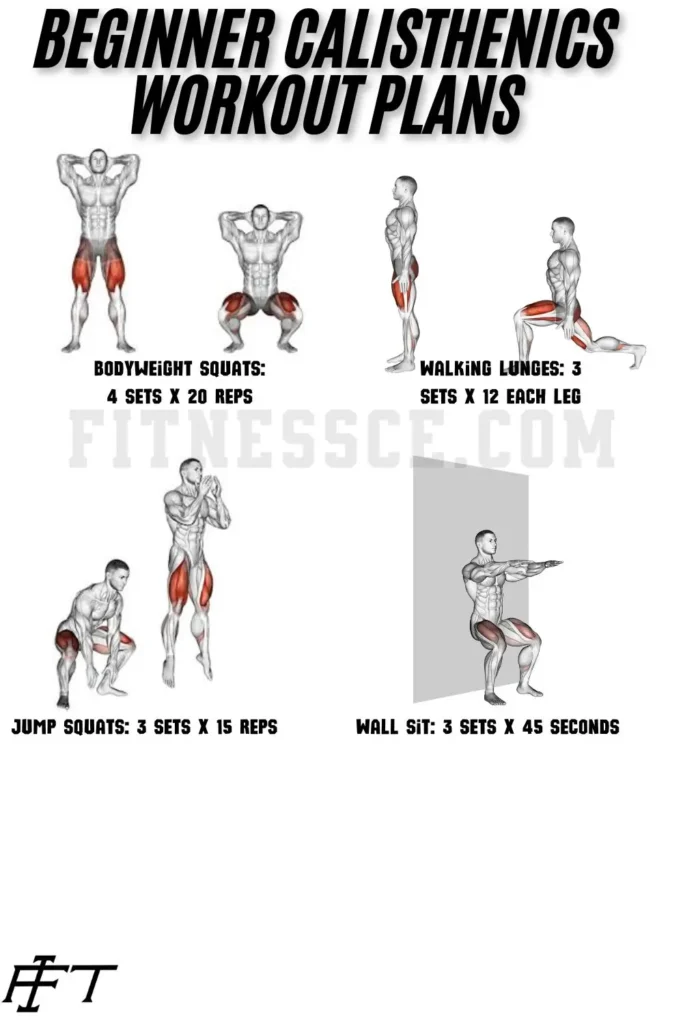
Day 4: Core & Mobility
- Hanging leg raises: 3 sets x 10 reps
- Russian twists: 3 sets x 20 reps
- Plank variations: 3 sets x 45 seconds
- Mobility flow: 10 minutes

Plan 2: The Calisthenics Athlete
This routine emphasizes technical proficiency, muscle control, and rrecoveryessential for advanced movements.
Frequency: 3-4 days per week with active recovery Duration: 60 minutes
Each workout combines:
- Skill work (15 minutes)
- Strength work (30 minutes)
- Mobility work (15 minutes)
Sample strength portion:
- 5 sets of 5 pull-ups (rest 2 minutes)
- 5 sets of 8 dips (rest 2 minutes)
- 3 sets of 12 pistol squat progressions (rest 90 seconds)
- 3 sets of L-sit progression (max hold)
Advanced Calisthenics Workout Plans
These plans are for those who have mastered the basics and are ready for the extraordinary.
Plan 1: The Bodyweight Beast
This challenging calisthenics workout plan explores the limits of bodyweight strength and control.
Frequency: 5 days per week Duration: 60-75 minutes
Key exercises include:
- Muscle-up progressions
- Front lever training
- Human flag progressions
- One-arm push-up work
- Pistol squat variations
- Handstand push-up training
Plan 2: The Calisthenics Pro
Focus on mastering elite techniques through targeted skill acquisition and specialized strength building.
Frequency: 6 days per week (skill-based approach) Duration: Variable (30-90 minutes)
This program uses a daily undulating periodisation model with specific focus days:
- Straight arm strength day
- Bent arm strength day
- Skill acquisition day
- Endurance/volume day
- Max strength day
- Active recovery day
Specialised Calisthenics Workout Plans
Plan 1: Calisthenics for Fat Loss
Combining high-intensity calisthenics with interval training creates a powerful fat-burning stimulus.
Key components:
- HIIT circuits (20 seconds work, 10 seconds rest)
- Compound movement focus
- Minimal rest between exercises
- Strategic nutrition (slight caloric deficit with adequate protein)
Sample circuit:
- Burpees
- Mountain climbers
- Jumping lunges
- Push-ups
- Jumping jacks
- High knees
Repeat for 4 rounds with 60 seconds rest between rounds.
Plan 2: Calisthenics for Core Strength
A strong core is the foundation for all advanced calisthenics movements.
Key exercises:
- L-sits
- Hanging leg raises
- Dragon flags
- Ab wheel rollouts
- Hollow body holds
- Side plank variations
Structured as a 3-day program with progressive difficulty.
Plan 3: Calisthenics for Mobility & Flexibility
This specialized plan integrates dynamic flexibility work with strength training.
Components:
- Dynamic stretching routines
- Mobility drills
- Active flexibility training
- Isometric strength at end ranges
- Animal flow movements
Plan 4: Calisthenics for Upper Body Strength
Focus on building impressive upper body strength through targeted progressions.
Key areas:
- Pull-up variations targeting different grip positions
- Push-up progressions leading to one-arm work
- Dip variations for triceps and chest development
- Handstand progressions for shoulder strength
- Scapular control exercises
Plan 5: Calisthenics for Lower Body Strength
Contrary to popular belief, calisthenics can build tremendous lower-body strength.
Progressive exercises:
- Squat variations (bodyweight → shrimp → pistol)
- Lunge progressions
- Natural leg extensions
- Nordic hamstring curls
- Calf raise variations
- Jumping progressions for power
Community Contributions
User-Submitted Workout Plans
Our community members have achieved impressive results with these modified plans:
Sarah’s 12-Week Transformation Plan
- Focused on pull-up progression
- Added weighted calisthenics after week 6
- Results: First muscle-up and 8% body fat reduction
Mark’s Minimalist Routine
- Just 20 minutes daily
- Consistent progressive overload
- Results: Gained visible muscle definition in 8 weeks
Workout Plan Ratings & Reviews
Based on over 500 community reviews, these are our highest-rated beginner calisthenics workout plans:
- The Foundation Builder (4.8/5 stars)
- The 30-Day Pull-up Challenge (4.7/5 stars)
- The Mobility-First Approach (4.6/5 stars)
Common feedback includes appreciation for clear progression paths and realistic time commitments.
Q&A Forum Highlights
Q: How often should I change my calisthenics workout plan? A: For beginners, stick with a program for 6-8 weeks before making significant changes. This allows time for neuromuscular adaptation and skill development.
Q: Can I build muscle with just calisthenics? A: Absolutely! Research shows that progressive calisthenics training can stimulate muscle hypertrophy in a way comparable to traditional weight training when progression principles are applied consistently.
Q: Do I need any equipment to start? A: No equipment is needed, though a pull-up bar will eventually become valuable for upper body development.
Conclusion
The beauty of calisthenics lies in its simplicity, accessibility, and effectiveness. By starting with the fundamental movements and progressively challenging yourself with more advanced variations, you’ll build functional strength, improve mobility, and develop a physique that’s as capable as it is impressive.
Whether your goal is muscle building, fat loss, or mastering impressive skills like muscle-ups or handstands, the right calisthenics workout plan can get you there. The key is consistency, proper progression, and patience with the process.
Ready to experience the transformative power of bodyweight training? Start with the Foundation Builder plan today, track your progress, and join our community for support and motivation along your calisthenics journey.
















